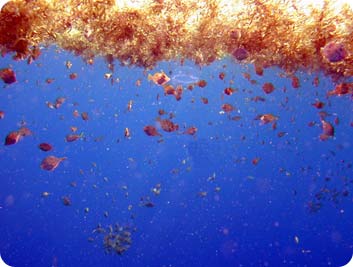Vast ribbons of life undulate across the oceans and seas. They’re packed with fish, sea turtles, and sometimes even wriggling masses of sea snakes. These ribbons are known as driftlines. They’re collections of floating seaweed, sticks, and other debris. They form at the boundaries between ocean currents, where the debris is pushed together to form patches or lines. Some are fairly small, but others can stretch for miles.
 Small fish live in sargassum driftlines. Credit: National Oceanic and Atmospheric Administration
Small fish live in sargassum driftlines. Credit: National Oceanic and Atmospheric AdministrationPerhaps the most famous driftlines are those formed by strands of sargassum -- a brown seaweed that’s common off the Atlantic and Gulf coasts of the United States. But driftlines based on other types of seaweed are found around the world.
These masses of material support vibrant colonies of life. Newly hatched fish live near the surface, where they’re protected from predators. Juvenile fish live at a lower layer, with adults patrolling beneath, looking for an easy meal.
Many sea turtles high-tail it for driftlines as soon as they hatch, and may live there for years.
Sea snakes inhabit driftlines in the Pacific and Indian oceans. Hundreds of highly venomous yellow-bellied sea snakes are found in driftlines off the coast of Panama, for example.
But the same currents that bring in the seaweed also bring in trash -- plastic bags and bottles, fishing lines, and more. This debris is a particular problem for turtles, who can become entangled in it and drown. So these long, thin ribbons of life can also be deathtraps for many of the creatures who live there.

